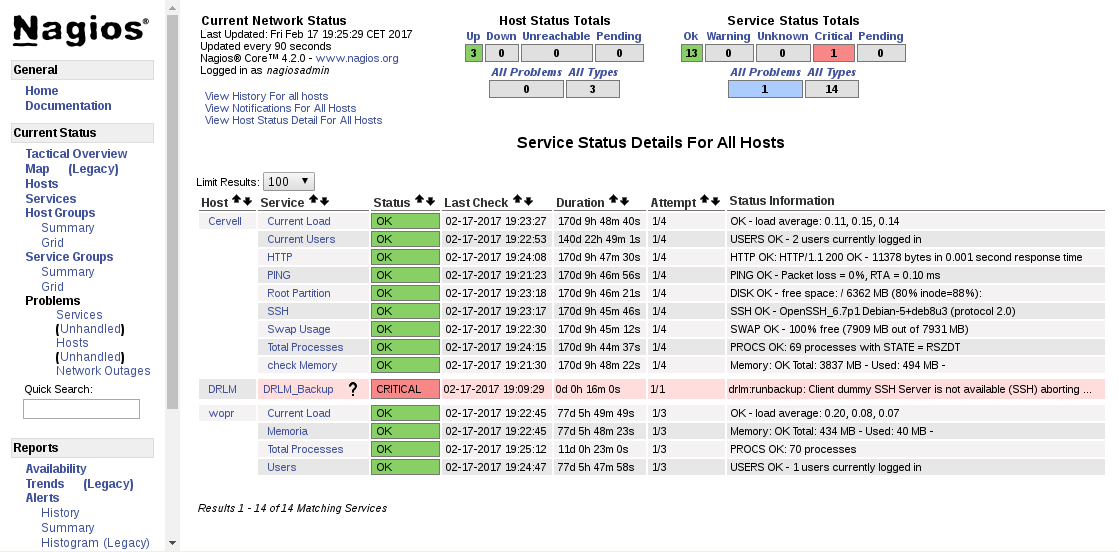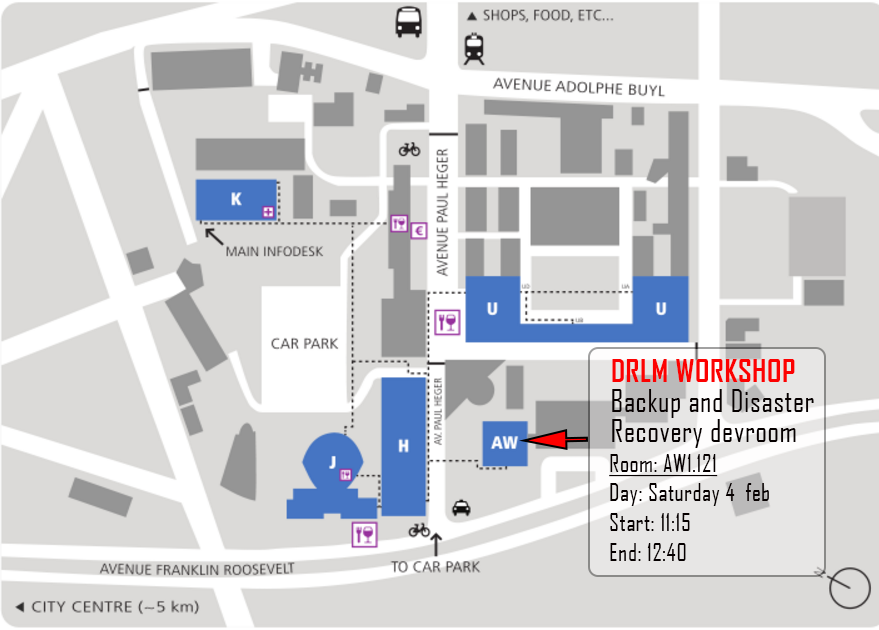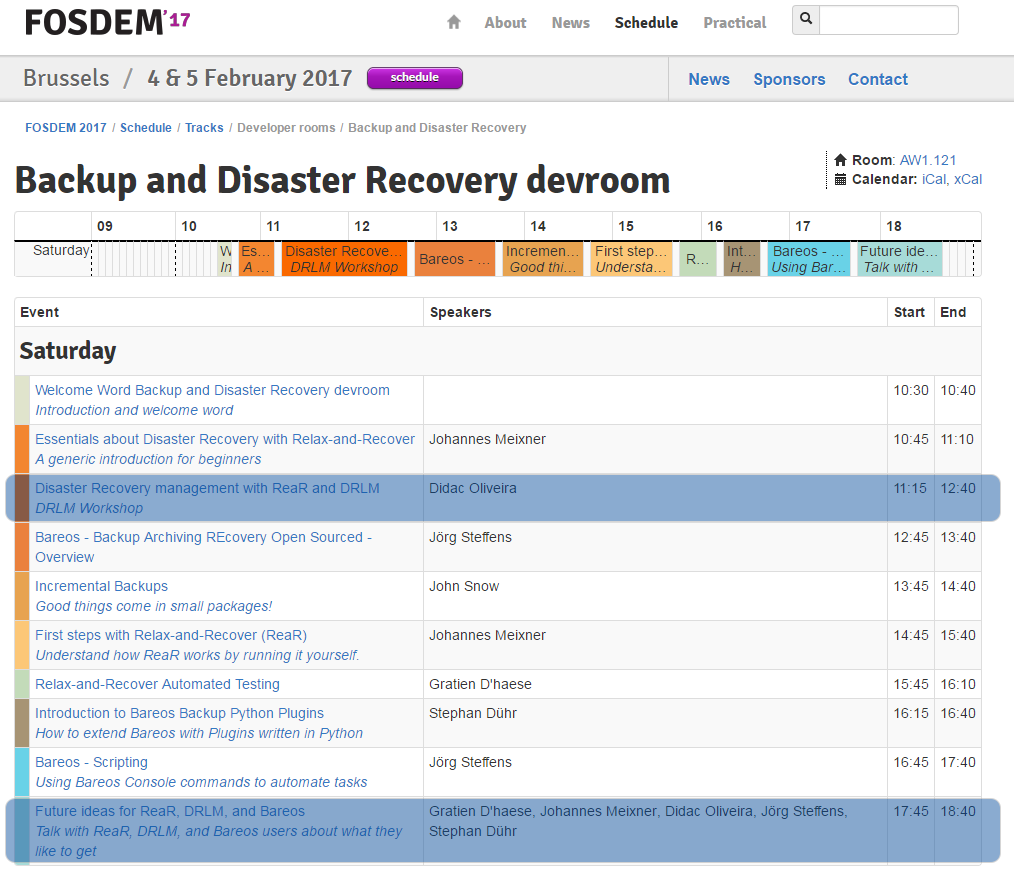Author: admin
BrainUpdaters becomes a RedHat Technology Partner
RedHat Technology Partner
With this new relationship, now we have the best resources and all the required tools to provide our Open Source solutions on RedHat technologies with the maximum guarantees.
This association confirms our idea of continuous improvement and we keep offering the best possible service to our customers.
Check our services.
Setup Nagios Server with
nsca-ng for DRLM
One of the methods of error reporting with DRLM is nsca-ng, there is a sample configuration on http://docs.drlm.org/en/latest/ErrorReporting.html . In this document we cover the configuration Nagios Server with nsca-ng and also DRLM Server configuration to monitor errors from DRLM Server when running backups.
Of course we assume you have a Nagios Server configured and a DRLM Server
if not, don’t worry, just take a look on the next links
How to install DRLM
How to install NAGIOS
DRLM Server configuration
Install nsca-ng-client package
$ apt install nsca-ng-client
Set up config files
At least 2 files must be configured, in thes example we’re using 3, default.conf has the default values that can be overwritten in local.conf
/usr/share/drlm/conf/default.conf
# REPORT_TYPE=nagios # NAGIOS VARIABLES # # These are default values and can be overwritten in local.conf according to your NAGIOS installation and configuration. # NAGCMD="/usr/sbin/send_nsca" NAGSVC="DRLM" NAGHOST="$HOSTNAME" NAGCONF="/etc/drlm/alerts/nagios.cfg"
Note
Keep an eye on this variable NAGSVC . We’re going to use it on the Nagios server side as a service description it must match.
/etc/drlm/local.conf
NAGSVC="DRLM_Backup"
Note
As you can see this varible was defined previously on default.conf , it is just to show you than it can be overwritten with the /etc/drlm/local.conf file, so if you want, you can dismiss this step.
/etc/drlm/alerts/nagios.cfg
#### DRLM (Disaster Recovery Linux Manager) Nagios error reporting sample configuration file. #### Default: /etc/drlm/alerts/nagios.cfg ### identity = <string> # Send the specified client identity to the server. # By default, localhost will be used. identity = "DRLM" ### server = <string> # Connect and talk to the specified server address or hostname. # The default server is "localhost". server = "Cervell" ### port = <string> # Connect to the specified service name or port number on the # server instead of using the default port (5668). port = 5668 password = "change-me"
Where:
- DRLM: Is the name of the DRLM Server
- Cervell: Is the name of the Nagios Server
- port: Is the port where the Nagios Server is listening
- password: Is the default password on the nsca-ng-server
Nagios Server configuration
Once the DRLM Server has been configured we’ll set up the Nagios Server.
Install required packages
$ apt install nsca-ng-server
Set up nsca-ng config files
/etc/nsca-ng/nsca-ng.cfg
command_file = "/usr/local/nagios/var/rw/nagios.cmd" listen = "Cervell" # only listen on localhost. If you use systemd this # this option is overriden by the # nsca-ng-server.socket file. user = "nagios" # run as user nagios pid_file = "/var/run/nsca-ng/nsca-ng.pid" # pid file for nsca-ng include(/etc/nsca-ng/nsca-ng.local.cfg) authorize "*" { password = "change-me" # # The original NSCA server permits all authenticated clients to submit # arbitrary check results. To get this behaviour, enable the following # lines: # hosts = ".*" services = ".*" }
Note
This config file has been reduced to only the minimum requirements , if you want to see all options check the original file /etc/nsca-ng/nsca-ng.cfg
/lib/systemd/system/nsca-ng-server.socket
[Unit] Description=NSCA-ng Socket Documentation=man:nsca-ng(8) man:nsca-ng.cfg(5) [Socket] ListenStream=5668 #BindIPv6Only=both [Install] WantedBy=sockets.target
Start nsca-ng-server service
$ systemctl start nsca-ng-server
- Check the status of the service
$ systemctl status nsca-ng-server ● nsca-ng-server.service - Monitoring Command Acceptor Loaded: loaded (/lib/systemd/system/nsca-ng-server.service; static) Active: active (running) since Fri 2017-02-17 18:35:46 CET; 5s ago Docs: man:nsca-ng(8) man:nsca-ng.cfg(5) Main PID: 14495 (nsca-ng) CGroup: /system.slice/nsca-ng-server.service └─14495 /usr/sbin/nsca-ng -c /etc/nsca-ng/nsca-ng.cfg Feb 17 18:35:46 cervell nsca-ng[14495]: Ignoring `-b'/`listen' when socket activated Feb 17 18:35:46 cervell nsca-ng[14495]: nsca-ng 1.4 (OpenSSL 1.0.1t, libev 4.15 with epoll) starting up
Nagios Config files
For this kind of configuration we’re using passive checks, the error notification is set for a limited time using the variable freshness_threshold. It’s importatnt to setup the notifications in order to receibe an email in case of error , if not you could miss it.
- Add a new service on
/usr/local/nagios/etc/objects/templates.cfg
define service{ name passive_service active_checks_enabled 0 passive_checks_enabled 1 # We want only passive checking flap_detection_enabled 0 register 0 # This is a template, not a real service is_volatile 0 check_period 24x7 max_check_attempts 1 normal_check_interval 5 retry_check_interval 1 check_freshness 1 freshness_threshold 600 contact_groups admins check_command check_dummy!0 notifications_enabled 1 ; Service notifications are enabled notification_interval 10 notification_period 24x7 notification_options w,u,c,r stalking_options w,c,u }
- Add the DRLM Server on a hostgroup
/usr/local/nagios/etc/object/hostgroup.cfg
define hostgroup { hostgroup_name Krbulan-Servers alias Servidors Test members DRLM }
- Add a new check
/usr/local/nagios/etc/object/commands.cfg
#NSCA-ng Command define command{ command_name check_dummy command_line $USER1$/check_dummy $ARG1$ }
- Define the host and service
/usr/local/nagios/etc/object/DRLM.cfg
define host{ use Host-krbulan host_name DRLM hostgroups Krbulan-Servers alias DRLM address 192.168.7.9 } define service{ use passive_service service_description DRLM_Backup host_name DRLM notifications_enabled 1 }
Warning
service_description has to match with the variable NAGSVC before configured on the DRLM server.
- Check Nagios configuration files
$ /usr/local/nagios/bin/nagios -v /usr/local/nagios/etc/nagios.cfg Nagios Core 4.2.0 Copyright (c) 2009-present Nagios Core Development Team and Community Contributors Copyright (c) 1999-2009 Ethan Galstad Last Modified: 08-01-2016 License: GPL Website: https://www.nagios.org Reading configuration data... Read main config file okay... Read object config files okay... Running pre-flight check on configuration data... Checking objects... Checked 16 services. Checked 3 hosts. Checked 2 host groups. Checked 0 service groups. Checked 1 contacts. Checked 1 contact groups. Checked 26 commands. Checked 5 time periods. Checked 0 host escalations. Checked 0 service escalations. Checking for circular paths... Checked 3 hosts Checked 0 service dependencies Checked 0 host dependencies Checked 5 timeperiods Checking global event handlers... Checking obsessive compulsive processor commands... Checking misc settings... Total Warnings: 0 Total Errors: 0 Things look okay - No serious problems were detected during the pre-flight check
Testing the configuration
From DRLM server exec runbackup (dummy server is not online)
$ root@DRLM:~# drlm -vD runbackup -c dummy Disaster Recovery Linux Manager 2.1.0 / Git Using log file: /var/log/drlm/drlm-DRLM-runbackup.20170217.190926.log ERROR: drlm:runbackup: Client dummy SSH Server is not available (SSH) aborting ... Aborting due to an error, check /var/log/drlm/drlm-DRLM-runbackup.20170217.190926.log for details Terminated
On Nagios

On the notifications we see that the mail has been send
![]()
BrainUpdaters takes part in the Backup and Disaster Recovery Devroom at FOSDEM’17
Disaster Recovery management with ReaR and DRLM Workshop
BrainUpdaters team will give a talk about DRLM, an opensource tool for centralized management of Disaster Recovery for Linux.
You will have the opportunity to go deeper into the DRLM (Disaster Recovery Linux Manager) tool and know more about the project history, features, news and a complete workshop on DR management with ReaR and DRLM.

We encourage you to attend to the talk and ask questions to our speaker, Didac Oliveria, co-founder and maintainer at DRLM Project.
Also an informal talk with ReaR, DRLM and Bareos users, about what they would like to implement in future ReaR, DRLM and Bareos versions will be offered to conclude all sessions of the Backup and Disaster Recovery Devroom.
Here more details about the talks and the schedule:




